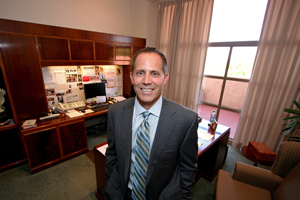
The tarnished legacy of Countrywide Financial Corp. is living on today through unresolved lawsuits and mortgages that continue to deteriorate.
But inside the gated Calabasas compound that once served as Countrywide’s headquarters, the business of making mortgages continues with a mix of faces new and old.
Bank of America Corp., which acquired Countrywide in January 2008, recently moved its mortgage operations from the banking giant’s Charlotte, N.C., corporate headquarters to create the new Bank of America Home Loans division in Calabasas. The integration was completed this summer.
Though Bank of America received some criticism for the $2.5 billion acquisition, it immediately made the bank one of the largest lenders in virtually every major market in the country.
During the first half of the year, Bank of America was the largest lender in Los Angeles County, narrowly edging out San Francisco-based Wells Fargo & Co. Bank of America’s market share tops 15 percent, up from just 3.5 percent five years ago.
However, its loan volume is only about half of what Countrywide had at the height of the housing boom when the lender was the undisputed leader in subprime lending. Bank of America’s 15.5 percent market share translates to $3.74 billion in loans over six months; Countrywide made $16.3 billion in loans over the entire course of 2006.
At the same time, Bank of America Home Loans is trying to distance itself from Countrywide and its subprime legacy, even though many former Countrywide employees stayed on and remain at the local headquarters.
“Certainly with Countrywide and many other lenders there were reputational issues that surrounded them. We’re doing our best to position Bank of America Home Loans and its new brand in a positive light,” said Todd Dal Porto, enterprise sales executive with Bank of America Home Loans and the former president of wholesale lending for Countrywide.
That effort to position the brand, according to company executives, first means that the division does not make subprime loans and has tightened its lending standards. The majority of its loans today are standard 30-year fixed-rate loans conforming to Fannie Mae and Freddie Mac guidelines.
Executives also said they are helping borrowers make better informed decisions about mortgages. The lender has begun distributing “clarity commitments” to borrowers, which are one-page documents explaining the complex jargon on mortgage forms.
“While we, of course, encourage people to read every document, we know what human nature is. So the upfront summary and the summary at closing are very helpful,” Dal Porto said.
The bank also is working closely with homeowner groups and community organizations nationwide on homebuyer education programs. The bank has reason to ensure that its lending operations are transparent. Bank of America agreed in June to a $108 million settlement with former Countrywide borrowers who claimed they were misled by the lender and charged excessive servicing fees.
Legal matters stemming from Countrywide’s activities are still not entirely resolved. Angelo Mozilo, who co-founded Countrywide in 1969, and two other former executives are scheduled to go on trial Oct. 19 for alleged fraud and insider trading.
Meanwhile, Bank of America Home Loans is still a ways from profitability. In the second quarter, the bank’s home loans and insurance operations reported a net loss of $1.5 billion on revenue of $2.8 billion. The loss stems largely from deteriorating mortgages: Bank of America set aside $2.4 billion to cover loan losses in the division.
“We have a large portfolio and we’re working through the challenges,” said Dal Porto, noting that the majority of the loans are current.
Bert Ely, a bank consultant in Alexandria, Va., said that for all the problems that Bank of America inherited with the Countrywide acquisition, the mortgage division has a better outlook than smaller financial institutions. The independent lenders may have a tougher time meeting new industry regulations, including higher capital requirements and increased liability for bad loans.
“I think the larger banks are going to get bigger and we definitely are going to see more consolidation and therefore more concentration in mortgage lending,” Ely said.
LARGEST LENDER
Bank of America Home Loans
Calabasas
Top Local Executive: Barbara Desoer
Focus: Prime conforming and jumbo loans
